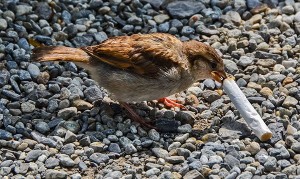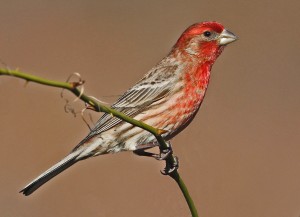As one year turns to the next, many of us will be resolving to make changes in our lives. A commitment to stop smoking in the new year is a time-honored tradition. However, that tradition may not be quite so well established in birds.
The lives of birds that live in cities attract the attention of many biologists. It seems that birds with a degree of behavioural flexibility, including the ability to exploit new resources and deal with novel challenges, are the species best able to take advantage of urban environments. Studies have shown that urban-dwelling birds consume novel foods, change the structure and pitch of their songs, and alter the timing of nesting, all to make the best of life in the city. Even so, some of the changes in bird behaviour seem a little peculiar.
Monserrat Suárez-Rodríguez and Constantino Macías Garcia of the Universidad Nacional Autónoma de México studied the use of cigarette butts by House Finches in the construction of their nests in Mexico City. Cigarette butts? Really? When this sort of behaviour has been seen in the past, it has been assumed that noxious chemicals remaining in the butt after the rest of the cigarette has been smoked may serve to reduce the infestation of ectoparasitic ticks, mites, fleas and so on. Intuitively, this explanation makes a lot of sense. We have long recognized the ability of ectoparasites to cause impaired incubation and brooding by parent birds and blood loss in their chicks. Furthermore, ectoparasites have the ability to transmit a wide range of nasty diseases from one bird to another.
Intuitive sense is one thing, but experimental evidence is another. After all, perhaps the cellulose fibres in a cigarette butt are utilized in nest construction because of their insulative value, and not for their ability to repel parasites. Suárez-Rodríguez and Garcia resolved to untangle the riddle.
Having identified a House Finch nest, the researchers waited for the resident female to finish laying her eggs. They then removed the lining of the nest, and replaced it with an artificial lining which was free of both ectoparasites and cigarette butts. Some of nests then received seventy live ticks, and some received seventy dead ticks. No ticks were added to a third group of nests.
Later, each nest was checked for the addition of cigarette butts by the parent birds. The results were clear. Those nests to which seventy live ticks were added subsequently received significantly more cigarette butts than nests which had dead ticks or were tick-free. Most of the butts had been woven into the lining of the nest. It seems that ectoparasites cause House Finches to add fibres from discarded cigarette butts to their nests, at least in Mexico City. Suárez-Rodríguez and Garcia described the behaviour of the finches as “self-medication.” Wild tobacco plants grow in Mexico City, but finches have not been seen to add leaves from these plants to their nests. It may be that butts are a better anti-parasite treatment than tobacco leaves themselves.
In the coming days, if you fail to keep to the resolutions for change that you have made, perhaps you can say that you are continuing on your destructive path for the sake of the birds.
Suárez-Rodríguez, M., and C. M. Garcia. 2017. An experimental demonstration that House Finches add cigarette butts in response to ectoparasites. Journal of Avian Biology 1316-1321.
Photo credits: House Finch hen collecting a cigarette butt, © Suárez-Rodriguez - www.sciencenewsforstudents.org; male House Finch © Judy Gallagher - http://www.flickr.com/photos/52450054@N04/6920300924/ (reproduced without modification by Creative Commons licence 2.0; https://creativecommons.org/licenses/by/2.0/)



